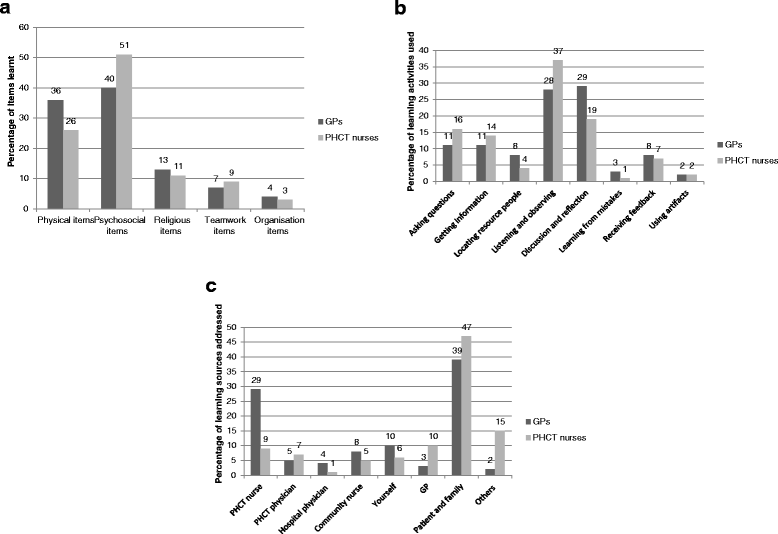What, how and from whom do health care professionals learn during collaboration in palliative home care: a cross-sectional study in primary palliative care
- PMID: 25377856
- PMCID: PMC4226882
- DOI: 10.1186/s12913-014-0501-9
What, how and from whom do health care professionals learn during collaboration in palliative home care: a cross-sectional study in primary palliative care
Abstract
Background: Palliative care often requires inter-professional collaboration, offering opportunities to learn from each other. General practitioners often collaborate with specialized palliative home care teams. This study seeks to identify what, how and from whom health care professionals learn during this collaboration.
Methods: Cross-sectional survey in Belgium. All palliative home care teams were invited to participate. General practitioners (n = 267) and palliative care nurses (n = 73) filled in questionnaires.
Results: General practitioners (GPs) and palliative care nurses learned on all palliative care aspects. Different learning activities were used. Participants learned from all others involved in patient care. The professionals' discipline influences the content, the way of learning and who learns from whom. Multiple linear regression shows significant but limited association of gender with amount of learning by GPs (M < F; p = 0.042; Adj R2 = 0.07) and nurses (M > F; p = 0.019; Adj R2 = 0.01).
Conclusions: This study is the first to reveal what, how and from whom learning occurs during collaboration in palliative care. Training professionals in sharing expertise during practice and in detecting and adequately responding to others' learning needs, could optimize this way of learning.
Figures
Similar articles
-
Teamwork in primary palliative care: general practitioners' and specialised oncology nurses' complementary competencies.BMC Health Serv Res. 2018 Mar 7;18(1):159. doi: 10.1186/s12913-018-2955-7. BMC Health Serv Res. 2018. PMID: 29514681 Free PMC article.
-
Interprofessional collaboration within fluid teams: Community nurses' experiences with palliative home care.J Clin Nurs. 2019 Oct;28(19-20):3680-3690. doi: 10.1111/jocn.14969. Epub 2019 Jul 5. J Clin Nurs. 2019. PMID: 31216390
-
Healthcare professionals' perceptions toward interprofessional collaboration in palliative home care: a view from Belgium.J Interprof Care. 2013 Jul;27(4):313-9. doi: 10.3109/13561820.2012.745488. Epub 2012 Nov 27. J Interprof Care. 2013. PMID: 23181267
-
What are the views of hospital-based generalist palliative care professionals on what facilitates or hinders collaboration with in-patient specialist palliative care teams? A systematically constructed narrative synthesis.Palliat Med. 2016 Mar;30(3):240-56. doi: 10.1177/0269216315615483. Epub 2015 Nov 4. Palliat Med. 2016. PMID: 26873984 Review.
-
[Palliative Care - not just for the final phase. A rewiev of evidence].Ther Umsch. 2018 Jul;75(2):123-126. doi: 10.1024/0040-5930/a000977. Ther Umsch. 2018. PMID: 30022722 Review. German.
Cited by
-
A phenomenological study of nurses experience about their palliative approach and their use of mobile palliative care teams in medical and surgical care units in France.BMC Palliat Care. 2020 Mar 20;19(1):34. doi: 10.1186/s12904-020-0536-0. BMC Palliat Care. 2020. PMID: 32197609 Free PMC article.
-
Variation in the implementation of PaTz: a method to improve palliative care in general practice - a prospective observational study.BMC Palliat Care. 2020 Jan 16;19(1):10. doi: 10.1186/s12904-020-0514-6. BMC Palliat Care. 2020. PMID: 31948417 Free PMC article.
-
Providing end-of-life care in general practice: findings of a national GP questionnaire survey.Br J Gen Pract. 2016 Sep;66(650):e647-53. doi: 10.3399/bjgp16X686113. Epub 2016 Jul 5. Br J Gen Pract. 2016. PMID: 27381483 Free PMC article.
-
Teamwork in primary palliative care: general practitioners' and specialised oncology nurses' complementary competencies.BMC Health Serv Res. 2018 Mar 7;18(1):159. doi: 10.1186/s12913-018-2955-7. BMC Health Serv Res. 2018. PMID: 29514681 Free PMC article.
-
Views of general practitioners on end-of-life care learning preferences: a systematic review.BMC Palliat Care. 2022 Sep 21;21(1):162. doi: 10.1186/s12904-022-01053-9. BMC Palliat Care. 2022. PMID: 36127706 Free PMC article.
References
-
- WHO 2010 Framework for Action on Interprofessional Education & Collaborative Practice [http://www.who.int/hrh/resources/framework_action/en/] - PubMed
-
- Gamondi C, Larkin P, Payne S. Core competencies in palliative care: an EAPC white paper on palliative care education – part 1. EJPC. 2013;20(2):86–91.
-
- Gamondi C, Larkin P, Payne S. Core competencies in palliative care: an EAPC white paper on palliative care education – part 2. EJPC. 2013;20(3):140–145.
Publication types
MeSH terms
LinkOut - more resources
Full Text Sources
Other Literature Sources
Medical


